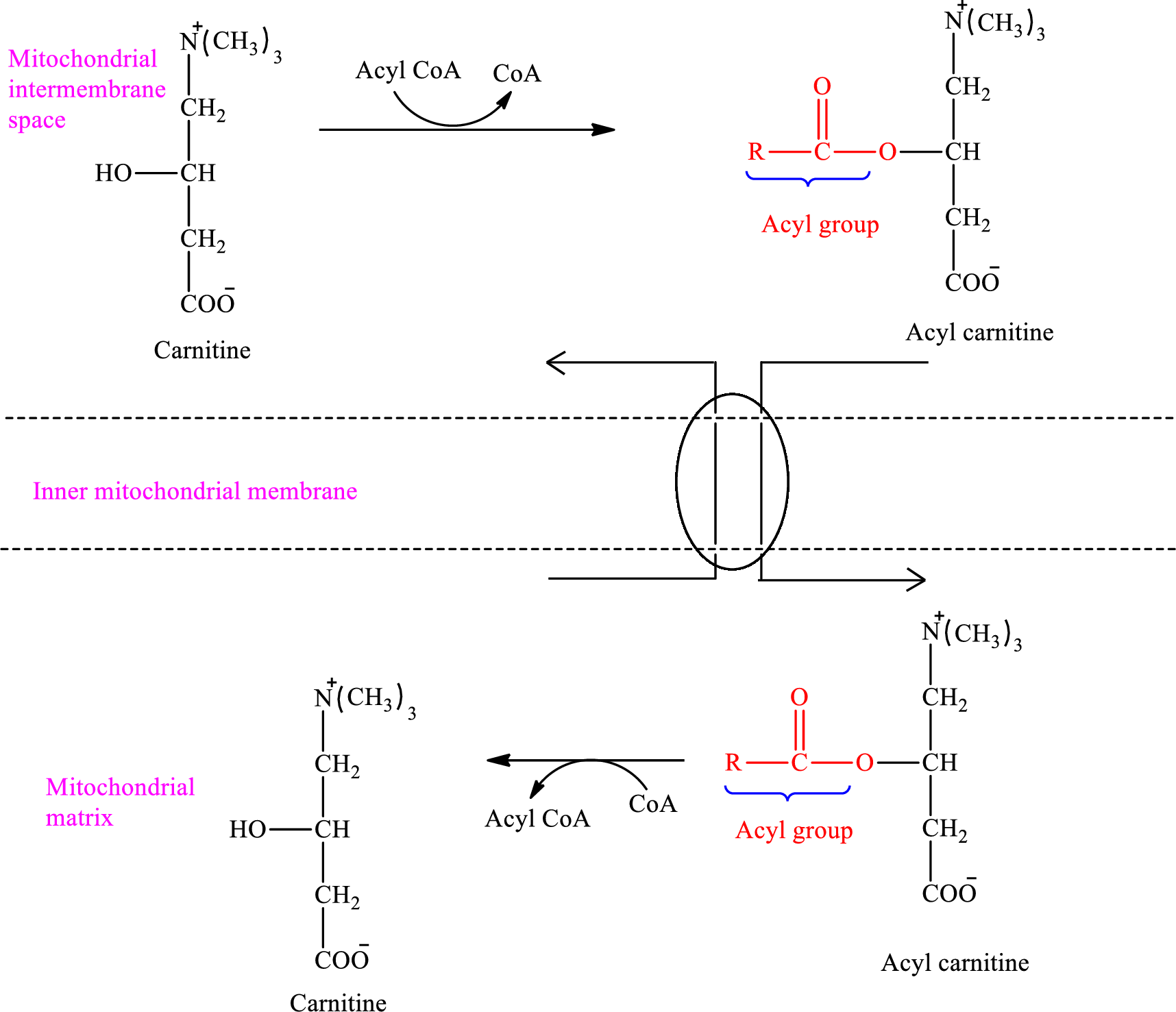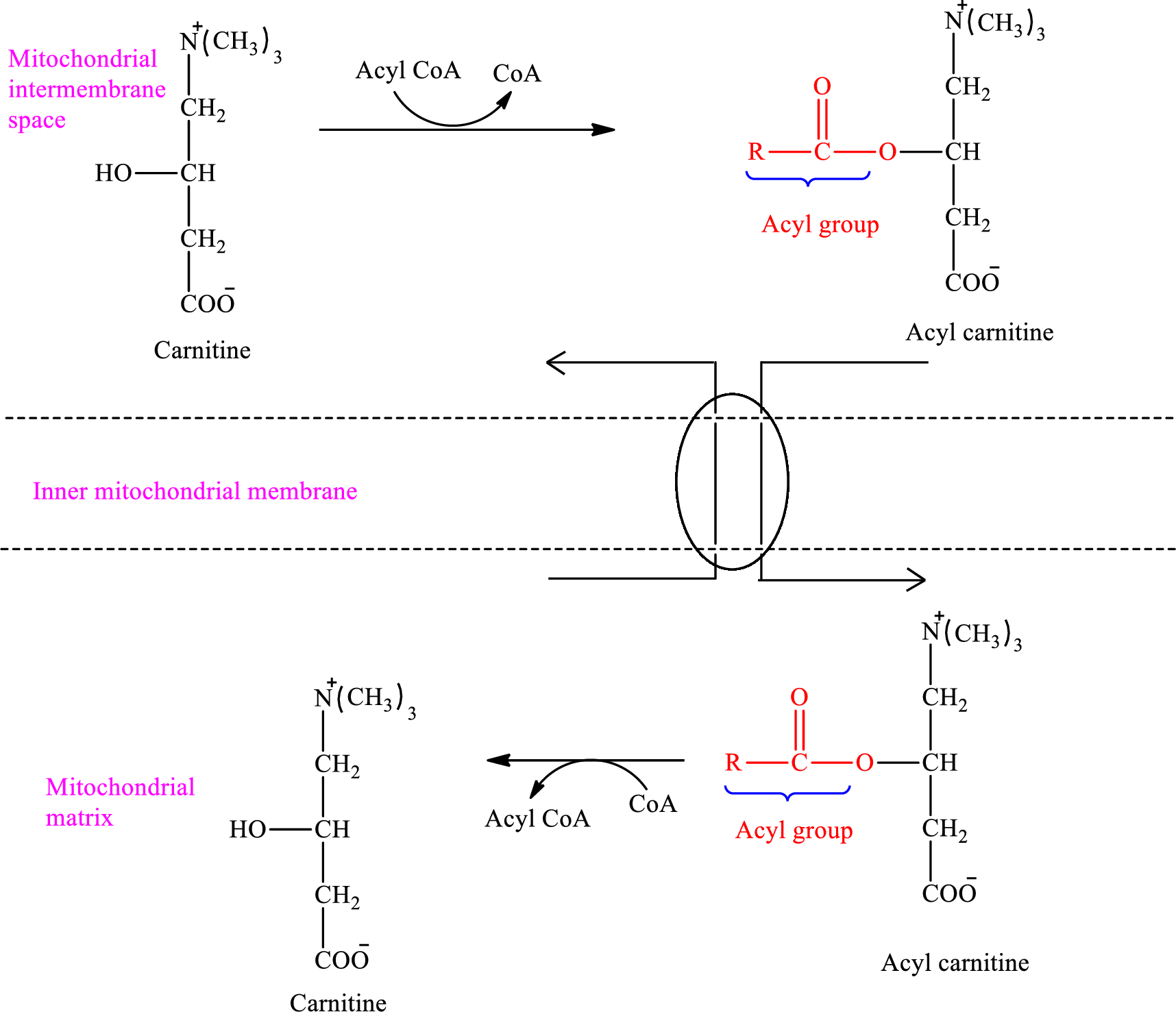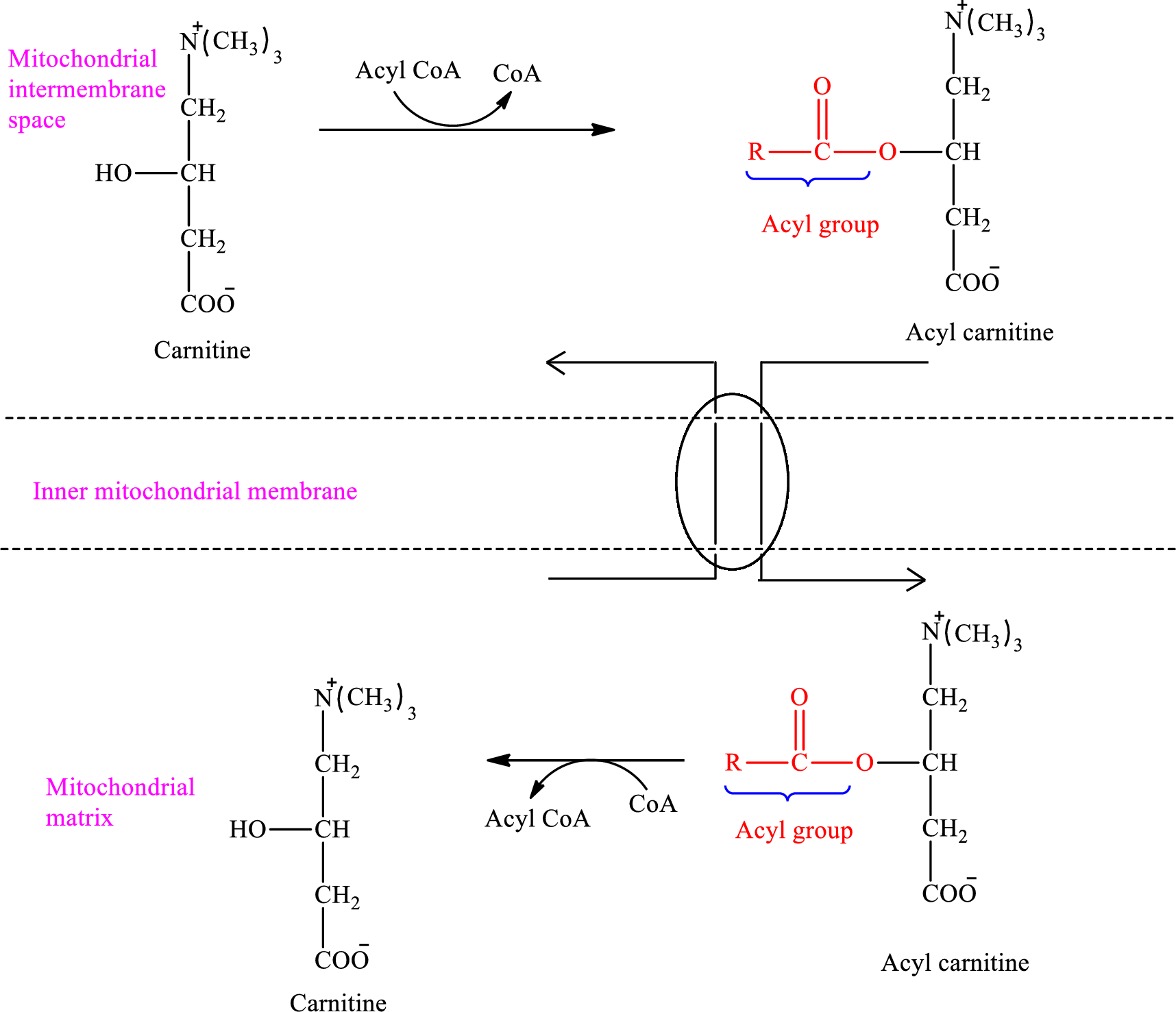
Concept explainers
(a)
Interpretation:
Whether “
Concept Introduction:
The fatty acids are broken down to provide energy. The breakdown of fatty acids is a three parts process. In the first part, the fatty acid is activated. In the second part, the transportation of fatty acid into the mitochondrial matrix is facilitated by a shuttle mechanism. In the third part, the fatty acid is readily oxidized, cycling through a series of four reactions.
The
The first stage of fatty acid oxidation is the activation of fatty acids in the outer mitochondrial membrane. The fatty acid is activated by
(a)
Answer to Problem 25.25EP
Explanation of Solution
The enzymes that are needed for the oxidation of fatty acid are located in the mitochondrial matrix. Acyl CoA cannot pass through the inner mitochondrial membrane to the mitochondrial matrix because it is too large. A shuttle mechanism that involves the molecule carnitine effects the entry of Acyl CoA into the mitochondrial matrix.
An overview of the transportation of Acyl CoA in the carnitine shuttle system associated with the

Therefore, Acyl CoA is encountered as a reactant in the intermembrane space.
(b)
Interpretation:
Whether “carnitine enters the inner mitochondrial membrane” in the mitochondrial matrix or in the mitochondrial intermembrane space in the carnitine shuttle system associated with the
Concept Introduction:
The fatty acids are broken down to provide energy. The breakdown of fatty acids is a three parts process. In the first part, the fatty acid is activated. In the second part, the transportation of fatty acid into the mitochondrial matrix is facilitated by a shuttle mechanism. In the third part, the fatty acid is readily oxidized, cycling through a series of four reactions.
The
The first stage of fatty acid oxidation is the activation of fatty acids in the outer mitochondrial membrane. The fatty acid is activated by
(b)
Answer to Problem 25.25EP
Carnitine enters the inner mitochondrial membrane in the mitochondrial matrix.
Explanation of Solution
The enzymes that are needed for the oxidation of fatty acid are located in the mitochondrial matrix.
An overview of the transportation of

Carnitine molecule shuttles the activated fatty acid molecules across the inner mitochondrial membrane. Therefore, carnitine enters the inner mitochondrial membrane in the mitochondrial matrix.
(c)
Interpretation:
Whether “carnitine is converted to acyl carnitine” in the mitochondrial matrix or in the mitochondrial intermembrane space in the carnitine shuttle system associated with the
Concept Introduction:
The fatty acids are broken down to provide energy. The breakdown of fatty acids is a three parts process. In the first part, the fatty acid is activated. In the second part, the transportation of fatty acid into the mitochondrial matrix is facilitated by a shuttle mechanism. In the third part, the fatty acid is readily oxidized, cycling through a series of four reactions.
The
The first stage of fatty acid oxidation is the activation of fatty acids in the outer mitochondrial membrane. The fatty acid is activated by
The enzymes that are needed for the oxidation of fatty acid are located in the mitochondrial matrix.
(c)
Answer to Problem 25.25EP
Carnitine is converted to acyl carnitine in the mitochondrial intermembrane space.
Explanation of Solution
Acyl group present in
An overview of the transportation of

Therefore, carnitine is converted to acyl carnitine in the mitochondrial intermembrane space.
(d)
Interpretation:
Whether “free
Concept Introduction:
The fatty acids are broken down to provide energy. The breakdown of fatty acids is a three parts process. In the first part, the fatty acid is activated. In the second part, the transportation of fatty acid into the mitochondrial matrix is facilitated by a shuttle mechanism. In the third part, the fatty acid is readily oxidized, cycling through a series of four reactions.
The
The first stage of fatty acid oxidation is the activation of fatty acids in the outer mitochondrial membrane. The fatty acid is activated by
The enzymes that are needed for the oxidation of fatty acid are located in the mitochondrial matrix.
(d)
Answer to Problem 25.25EP
Free
Explanation of Solution
Acyl group present in
An overview of the transportation of

Therefore, free
Want to see more full solutions like this?
Chapter 25 Solutions
General, Organic, and Biological Chemistry
 Organic And Biological ChemistryChemistryISBN:9781305081079Author:STOKER, H. Stephen (howard Stephen)Publisher:Cengage Learning,
Organic And Biological ChemistryChemistryISBN:9781305081079Author:STOKER, H. Stephen (howard Stephen)Publisher:Cengage Learning, General, Organic, and Biological ChemistryChemistryISBN:9781285853918Author:H. Stephen StokerPublisher:Cengage Learning
General, Organic, and Biological ChemistryChemistryISBN:9781285853918Author:H. Stephen StokerPublisher:Cengage Learning Chemistry for Today: General, Organic, and Bioche...ChemistryISBN:9781305960060Author:Spencer L. Seager, Michael R. Slabaugh, Maren S. HansenPublisher:Cengage Learning
Chemistry for Today: General, Organic, and Bioche...ChemistryISBN:9781305960060Author:Spencer L. Seager, Michael R. Slabaugh, Maren S. HansenPublisher:Cengage Learning Introduction to General, Organic and BiochemistryChemistryISBN:9781285869759Author:Frederick A. Bettelheim, William H. Brown, Mary K. Campbell, Shawn O. Farrell, Omar TorresPublisher:Cengage Learning
Introduction to General, Organic and BiochemistryChemistryISBN:9781285869759Author:Frederick A. Bettelheim, William H. Brown, Mary K. Campbell, Shawn O. Farrell, Omar TorresPublisher:Cengage Learning



